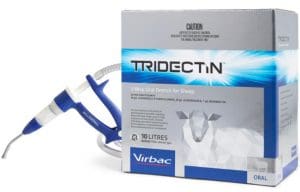 VIRBAC Australia has launched its world-first broad-spectrum combination drench Tridectin with the shortest export slaughter interval of any product of its type.
VIRBAC Australia has launched its world-first broad-spectrum combination drench Tridectin with the shortest export slaughter interval of any product of its type.
Virbac Australia launched Tridectin today as the world’s only broad-spectrum combination drench with a registered claim to kill triple-resistant and monepantel-resistant worms.
The product has received qualified industry support as a potent combination drench with ESI advantages and when used as part of a producer’s worm egg count and drench resistance management program.
Click here to get the latest Sheep Central story links sent to your email inbox.
The advanced patented formulation combines potent chemistry with the latest technology, providing a reliable, safe and effective solution against all the major worm species especially Barber’s Pole worm, small brown stomach worm, and black scour worm, Virbac said.
The company said Tridectin’s triple action treatment contains three powerful actives designed to kill worms fast, making it ideal as a strategic pre-lamb or summer clean-out treatment, or as needed based on worm egg count results. It contains Moxidectin, Levamisole and Albendazole, for a ‘triple-pronged’ approach to worming.
Tridectin has a market-leading export slaughter interval (ESI) of just 17 days – eleven days shorter than other combination drenches – and is the only oral combination drench that continues to kill susceptible Barber’s Pole worm and small brown stomach worm for 14 days after drenching, delivering a longer period of protection, the company said.

Regional Director of SANZA for Virbac Australia John Embling.
John Embling, Regional Director of SANZA for Virbac Australia and Board Member of Animal Medicines Australia said the introduction of safe, more effective ag-vet chemicals can only be a good thing for our farmers, regional communities and environment.
Tridectin follows in the footsteps of Virbac’s drench Cydectin, building on Cydectin’s recognition and success over the past 23 years. Tridectin will be available at rural merchandising stores across Australia from September 25.
Tridectin’s shorter ESI valued
Hamilton veterinarian Dr David Rendell said Tridectin had a very valid place for producers who need to take advantage of the shorter withholding period if they want to retain flexibility of being able to market sheep post-drench promptly. He would still be recommending short duration abamectin-based ‘triples’.
Dr Rendell said regardless of which drench is used there was still a need to manage flock drench use within a program of worm egg count and drench resistance testing.
“It’s not a game-changer – I won’t be encouraging its widespread use, although it will have a useful role as a highly effective drench where a short ESI is needed.”
Greater potency is more important reason for use

Dr Brown Besier.
Private parasitology consultant Dr Brown Besier said Tridectin will have significant potential, as it will be the most potent of the triple combination drenches.
“All others are based on abamectin (plus albendazole and either levamisole or naphthalophos), and as moxidectin is significantly more potent than abamectin, it will kill some worms that those other won’t.
“The triple combinations have become very important as the single-active MLs fail: ivermectin resistance has been present for many years on most properties where sheep worms are a major issue; abamectin resistance is now widespread (50 percent or more of properties); and moxidectin resistance is now common, especially in the main Barber’s Pole worm areas,” he said.
“This limits options to the triple combinations, or the more expensive Startect or Zolvix.”
He said cost should not be an issue, as effectiveness is far more important, but in practice, cost is a big factor in drench decisions, and the triple combinations are now widely used.)
“I see the greater potency of Tridectin as by far the most important reason for its use, in addition to the general recommendation that all combination drenches are less likely to select for drench resistance than single-actives.”
Dr Besier said Tridectin’s “registered claim to kill triple-resistant and monepantel-resistant worms” meant acceptance of that feature by the Australian Pesticides and Veterinary Medicines Authority, on the basis of trial evidence.
“Activity against monepantel worms is likely to apply to some other products but it has not been tested in trials and submitted for registration, and the 14-day activity against Barber’s Pole worm applies to all moxidectin products.”
DR Besier said Tridectin’s shorter ESI may help in some situations, although most farmers would not be selling sheep for slaughter only four weeks after a drench, or would use another product.
“It is certainly true that such a potent product should be used in a program aimed at minimising drench resistance development — including worm egg count monitoring and pasture management — and I have been assured by Virbac staff that they recommend their products are used within the framework of drench resistance management programs, including refugia management.”
“So, in summary, I do see some advantages in Tridectin, on the basis of its relatively high potency, provided that it is used in the context of a drench resistance management program.”
Industry has an over-reliance on abamectin

New GSSA president Steve Cotton.
Hamilton-based agricultural consultant Dr Steve Cotton said continued investment by companies in new products was beneficial, because he believed the industry had an over-reliance on abamectin as a drug.
“Apart from Tridectin, all new and effective chemicals contain abamectin which is of concern to the industry.”
He hasn’t found any monepantel resistance in Victoria yet, but it has been identified in New South Wales.
“So I’m thinking that Virbac is looking into the future to develop a product to suit in due course.”
On the issue of triple resistance, Dr Cotton said of the 61 properties he has tested in the past five years, 98.4pc had greater than 95pc efficacy and 93.4pc with more than 98pc efficacy.
“With straight abamectin, 77.5pc of properties have greater than 95pc efficacy and 64.8pc more than 98pc.
“With straight moxidectin, 88.1pc of properties have greater than 95pc efficacy and 66.7pc more than 98pc.”
Dr Cotton said currently, triple combinations are used mostly during winter and spring and occasionally as a first summer drench.
“Will adding moxidectin in the mix change this? Not from my point of view.
“Resistance testing in the next 12 months will show how good it is,’ he said.
Dr Cotton said monitoring 10-14 days post-drenching will be a good way of assessing effectiveness.
“Where producers have been using oral Cydectin or ewe/weaner guard for some years, they should carefully think about where this will fit, again, a resistance test will aid this.”

HAVE YOUR SAY